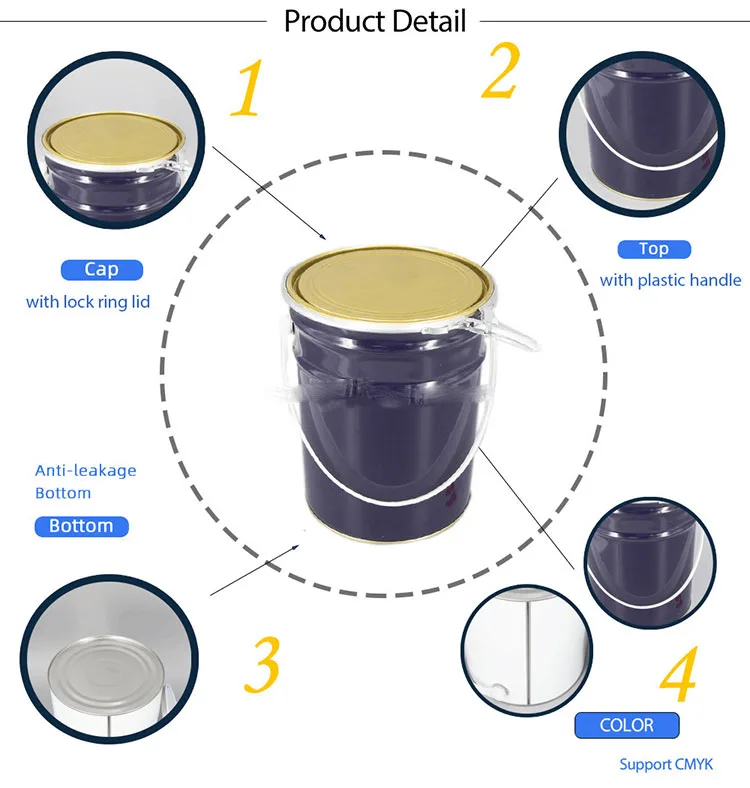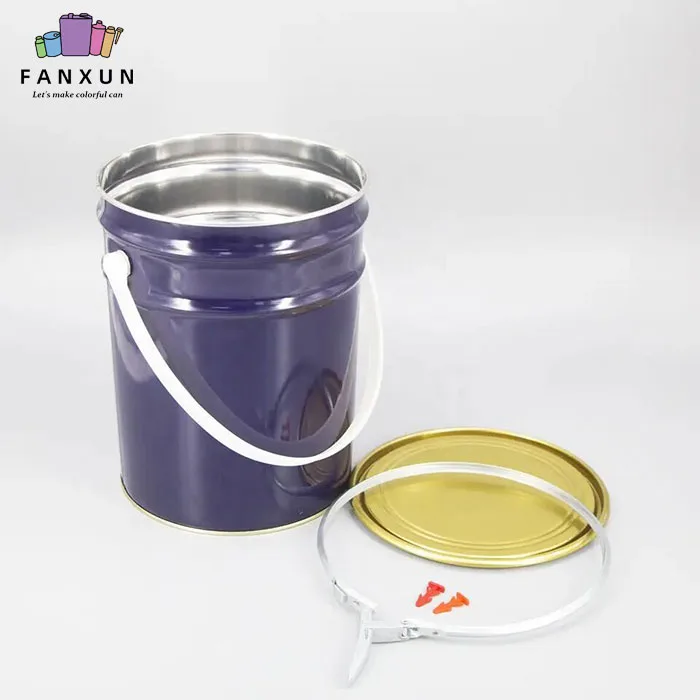When choosing a lidded metal bucket, there are several factors to consider to ensure that the bucket you choose meets your specific needs. Here are some important considerations when choosing a metal bucket with a lid:
Purpose and Contents: First, determine the types of items you plan to store or transport in the metal drum. Different items may require different types of metal drums, such as food-grade metal drums, chemical drums, liquid containers, vesaire.
Chemical and Hazardous Goods Storage:
Metal bucket with lid can also be used to store chemicals, hazardous waste, and hazardous materials such as acids, alkalis, solvents, paints, pesticides, and hazardous waste. These barrels are often required to meet specific safety standards.
Paint and coating storage:
Metal buckets are very useful when storing paint and coatings because they effectively seal the paint, preventing it from drying out or leaking. This also includes the storage of materials such as asphalt, asphalt paint, vesaire. on construction sites.
Industrial raw material storage:
Metal barrels are used to store various industrial raw materials, such as grease, yağlama yağı, chemical raw materials, plastic particles, vesaire. These barrels resist chemical corrosion and mechanical stress
Food storage:
Food-grade metal barrels with lids are usually used to store food and beverages, such as rice, flour, sugar, coffee, juice, honey, vesaire. These barrels usually have a food-grade coating to ensure food safety and hygiene


Capacity and Size: Determine the required capacity and size. Consider the number and size of items being stored or transported, and then choose the appropriate metal bucket size. Metal drums often come in a variety of capacity options.
The capacity and size of lidded metal drums can vary depending on specific uses and needs. Here are some common lidded metal drum capacity and size ranges, but please note that these sizes may vary depending on the manufacturer and supplier’s product line:
Small metal bucket:
- Capacity: usually between 5 Ve 20 liters.
- Boyut: diameter is about 10 ile 12 inches, height is about 12 ile 18 inches.
- Capacity: usually between 20 Ve 100 liters.
- Boyut: diameter is about 14 ile 20 inches, height is about 18 ile 30 inches.
Large metal bucket:
- Capacity: usually above 100 liters, or even hundreds of liters.
- Boyut: The diameter and height will increase significantly, and the specific size depends on the capacity.
It is important to note that the shape of metal buckets can vary depending on the manufacturer and purpose. Some metal barrels may be wider and flatter, while others may be taller and slimmer. Additionally, some metal barrels may have special designs to meet specific needs, such as square or rectangular shapes.
Choosing the capacity and size of a metal bucket should be based on your specific needs and usage. Consider the following factors:
- Type and quantity of items stored or transported.
- Space limitations for storage or transportation, such as the size of the warehouse or vehicle where metal barrels are stored.
- The required storage period, that is, whether long-term storage or short-term transportation is required.
- The ability of the operator, such as what size barrels the person carrying the metal barrels can handle.
- Special needs, such as capacity and size that comply with specific industry standards or regulations.
Other points to note
Malzeme: Choose appropriate metal material. Steel and aluminum are common choices, with steel generally being stronger and suitable for heavy-duty use, while aluminum is lighter and suitable for situations where a lightweight container is required.
Sealing: Make sure the selected metal barrel has good sealing properties to prevent liquid leakage or solid items from being contaminated. The sealing cap is a key component to maintain tightness.
Security: If needed, choose metal buckets with security features, such as fire-resistant designs or locking mechanisms, to ensure the safety of stored items.
Corrosion Resistance: If your items tend to corrode metal, choose a metal bucket with a corrosion-resistant coating or material.
Recyclability: Consider whether you will need to use your metal bucket multiple times, and if so, choose a model that is designed to be sturdy and easy to clean and maintain.
Standards and Compliance: Make sure the metal drums you choose comply with applicable industry standards and regulations, especially for the storage and transportation of food, chemicals or hazardous materials.
Customization options: If you require specific customization, such as printing your company logo or adding accessories, discuss feasibility with your supplier.
